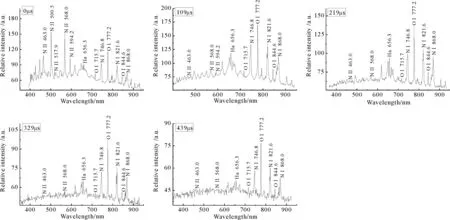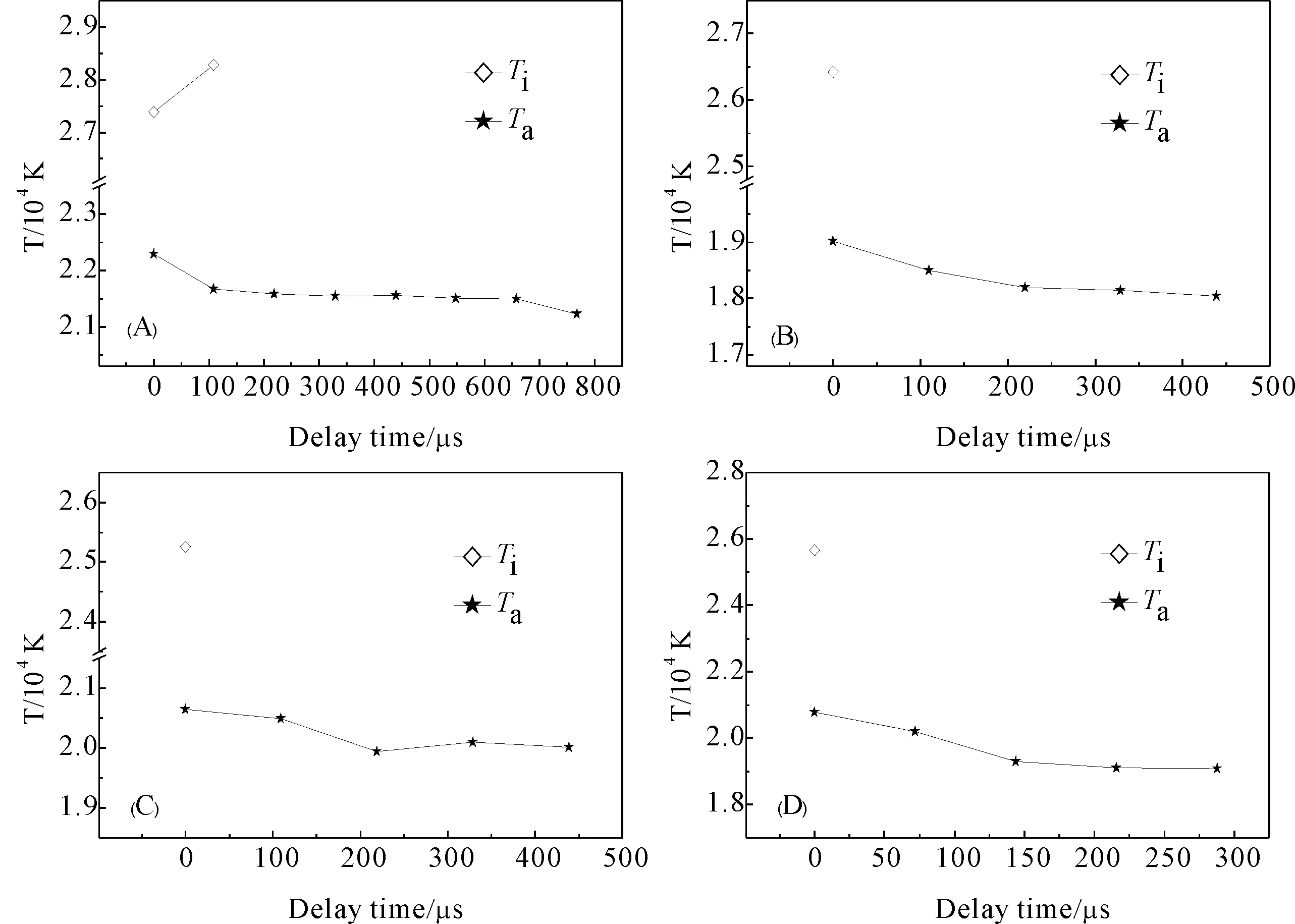闪电首次回击过程中通道温度与电导率的演化特征
张国强, 袁 萍, 岑建勇, 王雪娟, 王瑞燕
(西北师范大学物理与电子工程学院, 甘肃省原子分子物理与功能材料重点实验室, 兰州 730070)
闪电首次回击过程中通道温度与电导率的演化特征
张国强, 袁 萍, 岑建勇, 王雪娟, 王瑞燕
(西北师范大学物理与电子工程学院, 甘肃省原子分子物理与功能材料重点实验室, 兰州 730070)
利用以高速摄像机为记录系统组装的无狭缝摄谱仪,在青海地区获得了多次云对地闪电首次回击过程400-900 nm波长范围的时间分辨光谱,分别计算了闪电电流核心通道和外围发光通道的温度;结合空气等离子体的传输理论,获得了闪电通道的电导率,探讨了回击过程中通道温度及电导率的演化特征.结果表明,闪电电流核心通道的温度比外围通道高约5000-7000 K,并且,与以往关于通道峰值温度持续时间的观点不同,回击过程中,通道保持高温的时间远远大于峰值放电电流存在的时间,在回击电流缓慢减小的数百微秒内,核心电流通道维持20000 K以上高温,这一特性是热效应导致雷电灾害的主要根源.
闪电光谱; 温度和电导率; 空气等离子体的传输理论; 时间演化
1 引 言
闪电放电的瞬间高电流和强电磁辐射导致的危害一直是人类关注的问题,闪电通道物理特性是雷电防护和预警的理论基础[1,2].温度[3-6]和电导率[7-9]是反映闪电通道物理特性的基本参数,对研究闪电放电特性及能量的传输和分布、探讨放电过程的物理机制都有重要意义.Orville[10,11]和Uman[12]最早通过闪电光谱分析获得了通道温度.Xu等[13]初步分析了多回击闪电放电中各次回击的通道峰值温度的变化特性.Borovsky[14]计算了闪电等离子体温度在10000-20000 K时的电导率;Jagdish RAI[15]依据回击通道的电流和传输的能量,运用完全电离气体理论计算了电导率;Uman[16]通过精确求解Boltzmann方程计算了闪电通道温度接近峰值为2.40×104K时的电导率.Chang等[17]利用闪电光谱研究了闪电通道电导率、热导率和热扩散系数沿通道的变化.以往基于闪电光谱的工作只限于单独对可见或红外波段光谱的观测研究,另外,由于受光谱仪时间分辨率的限制,得到高时间分辨的闪电光谱具有一定的难度,目前为止,关于单次回击过程中通道温度及电导率随时间演化的研究报道还非常少.本文利用四次闪电的首次回击过程时间分辨的多张光谱,计算了闪电通道的温度、电导率,分析了这些参量随时间的演化特征.
2 理论方法
2.1 闪电通道温度的计算
在局部热力学平衡(LTE)条件下,通道温度[18]和光谱线跃迁参数的关系为
(1)
其中,I是谱线的相对强度,λ是波长,g是统计权重,A是跃迁几率,E是上激发能,k是玻尔兹曼常数,T是温度,c是常数,计算中选取同种元素的离子或原子的多条谱线,以ln(Iλ/gA)的值为纵坐标,E为横坐标进行线性拟合直线,由直线的斜率求出温度.
2.2 闪电通道电导率的计算
电导率是描述闪电放电通道的输运特性的参数之一,结合空气等离子体的传输理论[19-21],可表示为
(2)
上式中,qmp元取决于通道电子密度、粒子数密度以及碰撞积分[22].
3 资料分析
资料分析选取了在青海地区获得的四次首次回击过程的高时间分辨光谱.光谱由无狭缝光栅摄谱仪获得,其记录系统是高速摄像机,记录速度为每秒9110-13880帧,分光装置是每毫米600条的光栅,波长范围为400-900 nm[23].
原始光谱是闪电云外全通道分光的图片,可以转化为用相对强度表示的光谱图.图1是四次闪电首次回击(R0)不同时刻的光谱,为方便起见,四次回击分别用A(14:56:27)、B(17:06:33)、C(15:38:59)、D(15:49:43)表示,每个回击的第一张光谱都记为0时刻.四个回击能够持续记录到光谱的时间为288-768微秒.可以看出,不同闪电首次回击的光谱都是由可见和近红外波段的光谱线组成.可见光谱范围内主要是NII离子的谱线,近红外光波段的谱线主要是NI、OI、HI原子辐射的贡献,回击过程中,光谱结构和强度都有明显的变化.较强的离子线只出现在回击初期的几十微秒内,之后,离子线强度迅速衰减;另外,整个回击过程的光谱中,始终有较强的近红外波段的原子线.有关闪电放电电流波形的研究表明[24],回击电流通常在几微秒内达到峰值,大多数在30微秒内到半峰值,之后缓慢减小,电流持续时间一般可达数百微秒.由电流波形特征的研究结论和通道发光特性推断,图1给出的光谱应该对应于回击电流从峰值减小的过程,每个回击以0时刻标记的光谱中包括了峰值电流阶段的信息.由于设备时间分辨率的限制,目前还无法得到电流快速上升至峰值过程的时间分辨光谱.
图2给出了闪电首次回击过程中光谱总强度以及闪电原通道亮度随时间的演化,其中,闪电A、D没有拍到原放电通道.依据光谱仪所用平面光栅的分光原理,光源发光强度与光谱背景和谱线强度的总和正相关,即:在相同的观测距离和曝光参数下,闪电通道的发光强度与光谱总强度呈正比.图2(B)、(C)可以看出光谱总强度与通道亮度随时间的演化规律有很好的一致性.

A:14:56:27(R0)

B:17:06:33(R0)

C:15:38:59(R0)

D:15:49:43(R0)图1 用谱线相对强度表示放电通道的光谱图Fig. 1 Spectral graphs of lightning discharge channel represented by relative intensity

图2 光谱总强度与亮度随时间的变化(A)闪电(14∶56∶27);(B)闪电(17∶06∶33);Itotal-光谱总强度,L-亮度;(C)闪电(15∶38∶59);Itotal-光谱总强度,L-亮度;(D)闪电(15∶49∶43)Fig. 2 Total intensity of spectra and lightness varying with time (A)Lightning (14∶56∶27);(B)Lightning (17∶06∶33);Itotal-total intensity,L-lightness;(C)Lightning(15∶38∶59);Itotal-total intensity,L-lightness;(D)Lightning(15∶49∶43)
以往关于闪电光谱的工作由于光谱仪记录系统相关参数的限制,一次记录的光谱波长范围较小,不能同时观测到可见和近红外波段的谱线.闪电通道温度的计算也是分别依据可见范围内NII离子谱线或近红外波段的原子线强度及跃迁参数.本工作将光谱观测范围扩展到400-900 nm,从图1可以看出,在整个回击过程的光谱中,都记录到了很强的近红外波段NI、OI原子的谱线,它们对应跃迁上激发态的能量大多数在10-14 eV,而NII离子线对应跃迁上激发态的能量大多数在20-23 eV.由谱线结构及其激发能的特征推断,原子线和离子线应该是沿通道径向不同位置处的贡献,离子线主要来自核心电流通道,而原子线应该主要是外围通道辐射的贡献.有关闪电通道半径的研究也证实,光学观测得到的可视直径远大于闪电核心电流通道的直径.依据NII离子谱线计算的温度应该反映的是电流核心通道的状态[25],而通过原子线计算得到的是外围发光通道的温度.
依据(1)式分别用NII离子、OI原子的多条谱线计算了相应的通道温度.由于离子线强度迅速衰减,除闪电A,其余3个回击都只计算了回击初始时刻闪电核心通道的温度.闪电通道的电导率由(2)式得出.表1列出了首次回击中不同时刻的特性参数,其中t为演化时间,Ti为利用离子谱线计算所得的温度,Ta为利用原子谱线计算所得的温度,σ为核心电流通道的电导率.

表1 四次闪电首次回击中不同时刻的物理特性参数
Orville等人[10]依据闪电回击光谱中NII离子谱线的强度报道的通道峰值温度为26000 K-31000 K.Orville和Henderson[26]利用中性原子谱线777.4/794.7 nm(OI)和844.7/794.7 nm(OI)计算得到通道温度为13,000 K-17,000 K;Weidman[27]等人研究了人工触发闪电在近红外波段的光谱辐射特性,根据中性原子谱线868.0/1011.3 nm(NI)推得的通道平均温度为16,000 K.表1中,由NII离子谱线计算的核心电流通道的温度在25000-28000 K之间,由OI线得到的外围通道温度在18000-23000 K.表1中,本工作得到的闪电放电通道的电导率平均为1.94×104S/m.Uman[28]得到的闪电回击通道峰值温度为24000 K时,通道电导率为1.80×104S/m;Rakov[29]得到在温度不低于30000 K时,回击通道电导率的数量级为 104S/m.此外,Gorin等[30]在实验室测得:当温度在20000-40000 K时,长火花放电等离子体的电导率为1.0×104S/m~5.0×104S/m.表1给出的电导率均在这个范围中.
放电通道的温度主要取决于电流的热效应,另外也与径向的能量传输有关.图3给出了闪电核心通道以及外围通道温度随时间的演化.可以看出,整个回击过程中,外围通道温度一直维持20000 K左右高温,随时间略有减小.核心通道的温度比外围通道高约5000-7000 K.另外,从图1(A)的光谱可以看出,闪电A在109 μs的NII离子线强度比0 μs时减弱许多,但由于谱线间的相对强度变化不大,所以,计算得到的核心通道温度与0时刻(峰值电流阶段)相比没有降低.结合外围通道的温度演化特征可以推断:峰值电流之后,通道温度不会随之迅速降低.即:通道保持高温的持续时间远远大于回击峰值电流的持续时间.这一结论与以往提出的通道温度仅在放电峰值电流阶段出现峰值、之后迅速降低的观点不同[31].从理论上解释,通道维持高温是放电电流热效应的作用结果.回击初期,放电通道在电流达到峰值的几微秒内从接近室温升高到20000-30000 K,之后的数百微秒内,虽然电流逐渐减小,由于其持续作用,仍然可以使通道保持高温.这种持续高温产生的热效应应该是导致相关雷电灾害的主要根源.
图4为四次首次回击过程中通道的电导率随时间演化的变化特征.可以看出,与闪电通道温度的变化基本一致,整个回击过程中通道处于高导电状态.随着时间的演化,云中大量电荷被中和,相应的电场逐渐减小,所以,回击电流也随之逐渐减弱.

图3 温度随时间的变化(A)闪电(14:56:27);(B)闪电(17:06:33);(C)闪电(15:38:59);(D)闪电(15:49:43)Fig. 3 Temperature varying with time(A)Lightning(14:56:27);(B)Lightning(17:06:33);(C)Lightning(15:38:59);(D)Lightning(15:49:43)

图4 电导率随时间的变化Fig. 4 Electrical conductivity varying with time
4 结 论
依据时间分辨的闪电光谱,计算、探讨了首次回击过程中放电通道的温度随时间的演化特征.结果发现,在整个回击过程中的数百微秒内,通道维持20000 K以上的高温.这一结论对进一步研究森林火灾等热效应导致的雷电灾害的防护有重要的参考意义.
[1] Wang C X, Qie X S, Jiang R B,etal. Propagating properties of a upward positive leader in a negative triggered lightning[J].Acta.Phys.Sin., 2012, 61(03): 553(in Chinese)[王彩霞, 郄秀书, 蒋如斌, 等. 一次人工触发闪电上行正先导的传输特征[J]. 物理学报, 2012, 61(03): 553]
[2] Cen J Y, Yuan P, Qu H Y,etal. Analysis on the spectra and synchronous radiated electric field observation of cloud-to-ground lightning discharge plasma[J].Phys.Plasmas, 2011, 18(11): 113506.
[3] Li M, Wu J, Wang L P,etal. Electron temperature diagnostics of aluminium plasma in a z-pinch experiment at the“QiangGuang-1” facility[J].Chin.Phys. B, 2012, 21(12): 125202.
[4] Nakimana A, Tao H Y, Hao Z Q,etal. A comparison of single shot nanosecond and femtosecond polarization-resolved laser-induced breakdown spectroscopy of Al[J].Chin.Phys. B, 2013, 22(01): 014209.
[5] Wang R Y, Yuan P, Cen J Y,etal. The influence of the observation distance on the lightning channel temperature by spectroscopic diagnosis[J].Acta.Phys.Sin., 2014, 63(09): 478(in Chinese)[王瑞燕, 袁萍, 岑建勇, 等. 闪电通道温度诊断中观测距离的影响[J]. 物理学报, 2014, 63(09): 478]
[6] Lu T X, Zhao X Z, Cui Z F. The determination of the electron temperature and electron density of laser plasma from the emission spectra[J].J.At.Mol.Phys., 1994, 11(02): 120(in Chinese)[陆同兴, 赵献章, 崔执凤. 用发射光谱测量激光等离子体的电子温度与电子密度[J]. 原子与分子物理学报, 1994, 11(02): 120]
[7] Wang Z Q, Lan S. Electrical conductivity simulation of plasma based on local thermodynamic equilibrium[J].J.At.Mol.Phys., 2015, 32(02): 259(in Chinese)[王竹勤, 兰生. 局部热力学平衡状态下的等离子体电导率计算[J]. 原子与分子物理学报, 2015, 32(02): 259]
[8] Ning Y, Yan J, Wang J G. Electron elastic scattering cross section and electrical conductivity calculation of plasma[J].J.At.Mol.Phys., 2007, (S1): 75(in Chinese)[宁烨, 颜君, 王建国. 等离子体中电子弹性散射截面及电导率计算[J]. 原子与分子物理学报, 2007, (S1): 75]
[9] Wang X J, Yuan P, Cen J Y,etal. Study on the conductivity properties of lightning channel by spectroscopy[J].Spectrosc.Spect.Anal., 2013, 33(12): 3192(in Chinese)[王雪娟, 袁萍, 岑建勇, 等. 光谱法研究闪电通道的导电特性[J]. 光谱学与光谱分析, 2013, 33(12): 3192]
[10] Orville R E. A high-speed time-resolved spectroscopic study of the lightning return stroke:part II.A quantitative analysis[J].J.Atmos.Sci., 1968, 25(05): 839.
[11] Orville R E. A high-speed time-resolved spectroscopic study of the lightning return stroke:part III.A time-dependent model[J].J.Atmos.Sci., 1968, 25(05): 852.
[12] Uman M A, Orville R E.Electron density measurement in lighting from stark broadening of Hα[J].J.Geophys.Res., 1964, 69(24): 5151.
[13] Xu H, Yuan P, Cen J Y,etal. The changes on physical characteristics of lightning discharge plasma during individual return stroke process[J].Phys.Plasmas, 2014, 21(03): 033512.
[14] Borovsky J E. An electrodynamic description of lightning return strokes and dart leaders: Guided wave propagation along conducting cylindrical channels[J].J.Geophys.Res., 1995, 100(D2): 2697.
[15] Jagdish RAI. Conductivity and electron density of the return stroke lightning[J].Ann.Geophys., 1980, 36: 263.
[16] Uman M A. The conductivity of lightning[J].J.Atmos.Terr.Phys., 1964, 26(12): 1215.
[17] Chang Z S, Zhao N, Yuan P. Study of the transport parameters of cloud lightning plasmas[J].Phys.Plasmas, 2010, 17(11): 113514.
[18] Qu H Y, Yuan P, Zhang T L,etal. Analysis on the correlation between temperature and discharge characteristic of cloud-to-ground lightning discharge plasma with multiple return strokes[J].Phys.Plasmas, 2011, 18(01): 013504.
[19] D’Angola A, Colonna G, Gorse C,etal. Thermodynamic and transport properties in equilibrium air plasmas in wide pressure and temperature range[J].Eur.Phys.J. D, 2008, 46(01): 129.
[20] Colombo V, Ghedini E, Sanibondi P. Thermodynamic and transport properties in nonequilibrium argon,oxygen and nitrogen thermal plasmas[J].Prog.Nucl.Energy, 2008, 50(08): 921.
[21] Han D, Guo W K, Xu P,etal. Theoretical computation for non-equilibrium air plasma electrical conductivity at atmospheric pressure[J].Chin.Phys.Lett., 2007, 24(08): 2297.
[22] Devoto R S. Simplified expressions for the transport properties of ionized monatomic gases[J].Phys.Fluid., 1967, 10(10): 2105.
[23] Cen J Y, Yuan P, Xue S M. Observation of the optical and spectral characteristics of ball lightning[J].Phys.Rev.Lett., 2014, 112(03): 035001.
[24] Krider E P, Guo C. The peak electromagnetic power radiated by lightning return strokes[J].J.Geophys.Res., 1983, 88(C13): 8471.
[25] Golde R H(translated by Zhou S J, Sun J Q).Lightning[M]. Beijing: Electric Power Industry Press, 1981: 224.
[26] Orville R E, Henderson R W. Absolute spectral irradiance measurements of lightning from 375 to 880 nm[J].J.Atom.Sci., 1984, 41(21): 3180.
[27] Weidman C, Boye A, Crowell L. Lightning spectra in the 850-1400nm, near infrared, region[J].J.Geophys.Res., 1989, 94(D11): 13.
[28] Uman M A. The conductivity of lightning[J].Atmos.Terr.Phys., 1964b, 26(12): 1215.
[29] Rakov V A. Some inferences on the propagation mechanisms of dart leaders and return strokes[J].J.Geophys.Res., 1998, 103(D2): 1879.
[30] Gorin B N, Inkov A Ya. Investigation of a spark channel[J].Sov.Phys.Tech.Phys., 1962, 7(3): 235.
[31] Uman M A. Peak temperature of lightning[J].J.Atmos.Terr.Phys., 1964, 26(01): 123.
The evolution properties of channel temperature and conductivity during the lightning first return strokes
ZHANG Guo-Qiang, YUAN Ping, CEN Jian-Yong, WANG Xue-Juan, WANG Rui-Yan
(Key Laboratory of Atomic and Molecular Physics and Functional Materials of Gansu Province, College of Physics and Electronic Engineering, Northwest Normal University, Lanzhou 730070, China)
The time-resolved spectra in the range of 400-900 nm for the first return strokes of could-to-ground lightning return stroke process were obtained by a slit-less spectrograph with a high-speed camera as recording system at the Qinghai plateau of China.The temperatures of the lightning core current channel and peripheral light channel have been calculated respectively; Combining with the transport theory of air plasma, we have obtained the electrical conductivity in discharge channel, and discussed the evolution characteristic of channel temperature and the electrical conductivity.The results show that the lightning core current channel temperature is about 5000-7000 K higher than the peripheral light channel temperature.In the return stroke process, the time of keeping the high temperature in the channel is far greater than the exist time of the peak discharge current,the temperature of the lightning core current channel keeps maintaining above 20000 K continuously with the return current decreasing slowly in the hundreds of microseconds.And this characteristic is a major cause of thermal effect which leads to the lightning disaster.
Spectra of lightning; Temperature and electrical conductivity; The transport theory of air plasma; Time evolution
103969/j.issn.1000-0364.2015.12.028
2015-04-27
国家自然科学基金(11475139,11365019)
张国强(1989—),男,甘肃省天水市甘谷县人,硕士研究生,主要研究领域为大气环境中的原子与分子过程.
袁萍. E-mail: yuanp@nwnu.edu.cn
0433.4
A
1000-0364(2015)06-1078-07

